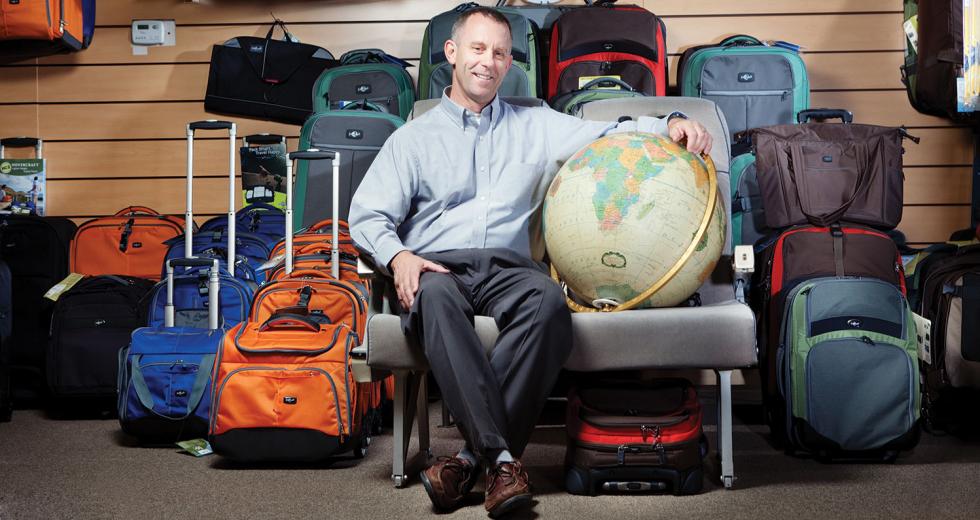While small specialty businesses in the Sacramento area are closing their doors in droves these days, Jon Holloway’s family-operated travel store is still sailing along, albeit in choppier waters.
His secret?
“Entirely saved by Internet sales,” Holloway says of his business, Holloway Travel Outfitters.
Retail analysts say brick-and-mortar shops nationwide are turning to the Internet to stay afloat, and those who miss the boat may wind up stranded.
Compelled by an increase in techno-â?¨savvy customers, better Internet technology and the need for expanding sales venues, Capital Region businesses are creating and cultivating an online presence. Some are using the Internet to inform and attract customers, and others are even using a Web page for online ordering and sales transactions.
But most retailers aren’t willing to take the plunge and ditch their storefronts. Instead, they’re using walk-in store locations in tandem with Internet sites to drive sales in the stalled economy. Cut-rate leases on commercial property in the Sacramento area are helping to keep shops anchored in the real world.
While the percentage of online sales is still a fraction of the overall retail picture — about 7 to 8 percent nationally — retailers without a website miss out on sales and promotional opportunities, says Ellen Davis, a spokesperson for the National Retail Federation in Washington.
“We see many people using the Web to help them make in-store purchases,” Davis says. “Customers check a store website for store hours, directions, customer reviews or to look at products or get gift ideas.”
The trade group estimates 20 to 25 percent of total retail sales are in some way influenced by the Internet, even by websites that aren’t capable of transacting online sales.
“It’s important for businesses to have an Internet site to list information about the store and, if possible, to conduct sales or shipping,” Davis says.
She recommended creating a “holistic strategy” dovetailing brick-and-mortar shops with online sites to maximize sales.
“Many businesses need a combination of a store, website, Facebook pages, traditional paper catalogs and mobile shopping applications,” she says. “You can’t focus on one or the other anymore. This tells the customer, ‘We don’t care how you shop, but choose us when shopping.’”
Davis says catalogs in magazine format are still useful, but retailers are finding the value of putting their catalogs on a website or Facebook page, so customers can scroll through the pages and easily access products, especially if they’ve lost or thrown out the catalog.
Holloway took over his store from his parents, so it’s a true mom-and-pop operation. His mother had the idea for a one-stop shop for travelers and opened 32 years ago, selling luggage, accessories and clothing.
At the time it opened, it was one of the first stores in the nation exclusive to travelers. While Holloway serves some business travelers, his target market is the retired person who has time and money to travel in style.
“We’ve gone through thick and thin,” he says. “Travel is a discretionary expense, so it really feels the fluctuations. With 9/11, the wars, changes in airline security, travel really took a hit.”
While his shop’s sales this year are up 23 percent overall from this time last year, he said last year’s sales were “horrendous.”
He started a website about 10 years ago, mainly for information. About seven years ago, he fleshed it out to include sales transactions, eventually adding a virtual shopping cart and payment options.
“I better have an Internet with sales capability,” Holloway says. “I wouldn’t be around without it. No one [would].”
His website, PackingLight.com, now gets business from across the U.S. and even some international sales. He gets about half his total sales from online transactions, and up to 99 percent of his online sales are from outside the Sacramento area.
“You can see the Internet booming. I mean, at Christmas, sales really increase,” Holloway says. He ordered a dozen styles of business cases to gear up for holiday Internet sales.
It’s not easy to launch and maintain websites, he says. Businesses with websites have to figure out ways to distinguish themselves on search engines, particularly Google.
“If you Google ‘travel store’ and ‘Sacramento,’ we come out No. 1,” Holloway says. The whole game is, ‘How do I get up in Google?’ That’s the game I’m playing.”
Holloway has spent thousands of dollars to construct his website and paid monthly fees to maintain it. He has taken courses in Web design and spent many long, frustrating nights tweaking the site.
The Web page allows customers to download videos of packing classes held at the store. Holloway also posts information for travelers, including a combined 2,000 travel tips and links to government sites for health and safety updates.
He is adding a platform with a new search box that’s supposed to increase conversion — the number of shoppers converted to buyers — by 40 percent.
“This is stuff you better be doing, and you have to do it yourself because you’re not going to have the money to hire someone,” says Holloway to small-business owners. “You either learn or have kids or grandkids who can help.”
There are other technological advances small businesses should be exploring, according to eMarketer. In a recent advertising report, the electronic marketing analysis firm says mobile advertising, or advertising via wireless phones or other mobile devices, is ramping up at a quicker pace than previously predicted.
“The tentative economic recovery can take some credit, but much of the responsibility goes to increased marketer awareness of the importance of using mobile as a channel to connect with consumers,” the report says.
The report goes on to say that major acquisitions of mobile ad networks by Google and Apple, the spiraling race to the market of smart phones and the iPad launch and distribution is spiking interest.
Spending on mobile advertising will grow more than six-fold between 2009 and 2014, reaching nearly $2.55 billion, according to eMarketer.
Businesses should also consider customer product reviews on their websites, which are becoming more common and expected, says eMarketer. An estimated 80 percent of retailers with websites favor adding them in some form by the end of this year.
“Reading product reviews is a growing part of consumers’ pre-purchase search ritual,” according to the analysis. “Over the past few years, consumers have increased the number of reviews they read and the overall time they spend reading them.”
As Holloway gets older, he’s looking at the possibility of closing the store and moving solely to an Internet site with a call center.
“I would love to just have a call center, and I’ve certainly thought about going all-Internet,” he says. “It would be easier. But our leasing agent just dropped the lease by 10 percent for the next three years, so we’re here for at least three years.”
According to a report by the Sacramento office of Colliers International, some shopping center space has gone from a prerecession price of $3 to $3.50 a square foot to a current $2 to $2.25 a square foot. So for now, Holloway is happy with the combination of real and virtual sales strategies.
“It’s undeniable that both modes tend to feed off each other,” Holloway says. “In terms of advertising, the website has far surpassed my expectations as a marketing tool.”
He said having a real location works well in conjunction with the website.
“People like that they can find us, that we really do travel, they know we’re local and that they can talk directly to someone at the store,” Holloway says. “People also like coming to the store to see products, to touch them and know the quality.”
The ability to compare conversely leads to one of the drawbacks of the permeation of Internet sales in retail markets: Smarter consumers looking for the best deals and wealthier customers looking for the best quality for the price.
Households with incomes of $100,000 or more contributed only about one-third of total U.S. retail online spending in the second quarter of 2010, according to ecommerce analyst comScore, but they accounted for two-thirds of growth in the ecommerce sector that quarter.
Wealthy consumers are part of a new wave of online shoppers not easily swayed by marketing hype, according to comScore. Empowered by the Internet, they can research online to find deals and compare product quality. Those skills have been sharpened by the recession.
Manfred Kallweit, owner of Pardee’s Cameras in Sacramento, knows this phenomenon all too well. He has a website for his specialty camera business, founded in 1946. The page is informational with some limited email and eBay shipping capability, but no shopping cart or payment process. He says it would be foolish for him to try to compete with mass online merchandisers from out of state, because they don’t collect sales tax.
“We have become basically an Internet showroom,” Kallweit says. “People come in, they get to know the product, they pick our brains, so to speak. Then they go on the Internet and find it cheaper.”
Kallweit differentiates between loyal customers and Internet shoppers. His loyal customers have kept him afloat, but his sales staff can spend up to an hour helping Internet shoppers, only to have them leave the store empty-handed.
“Photo equipment is not like clothes or appliances,” Kallweit says. “You can’t buy it online without holding it, fondling it. Cameras are complicated, and you have to feel it, ask questions about it. They want to try it out, so you follow them to the sidewalk outside.”
For some customers, this kind of knowledgeable service is rewarded with loyalty and a sale. Others tell Kallweit’s sales staff right off the bat that they are doing research to buy from another company online. When that happens, they attempt to woo the customer, since they’ve already set foot in the store.
“We try to tell people, ‘We will support you, take care of you,’” Kallweit says. “We teach photography over the counter every day.”
Kallweit says it wouldn’t be worth the money to launch an Internet sales site because of out-of-state competition. He understands a customer’s need to save money, however, especially in this economy.
“You can spend $10,000 on one camera and lens, so when you can save 8 percent or so in sales tax, that’s big,” he says.
Instead, his website, which he created about five years ago, has store information and history.
“It’s fun to have the website, so people can find out who we are and where we are,” Kallweit says. “People expect it.”
Recommended For You

Social Network
How crowdfunding connects strangers — and your business – to money
“Small Market, Big Heart” tells the story of the Sacramento Kings and their fans’ fight to hold onto the team. But the 80-minute documentary — packed with NBA archive footage and interviews with Kings’ executives, local politicians and sports entertainment personalities — isn’t from the NBA offices or an established production company.

14 for ‘14
The essential business metrics you need to track in the new year
New Year’s is the quintessential time for small businesses to make (and keep) resolutions for growth. But achieving your company’s 2014 goals hinges on knowing some important numbers, and many businesses never go beyond their income to identify and track essential metrics. Here are the 14 most important performance measures to track this year.



